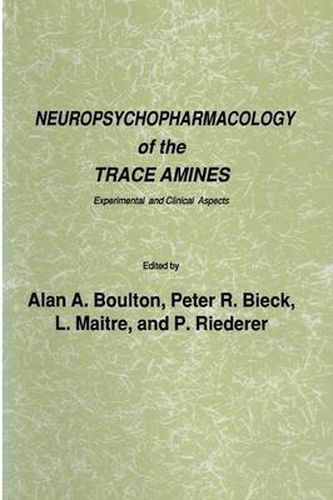Readings Newsletter
Become a Readings Member to make your shopping experience even easier.
Sign in or sign up for free!
You’re not far away from qualifying for FREE standard shipping within Australia
You’ve qualified for FREE standard shipping within Australia
The cart is loading…






This title is printed to order. This book may have been self-published. If so, we cannot guarantee the quality of the content. In the main most books will have gone through the editing process however some may not. We therefore suggest that you be aware of this before ordering this book. If in doubt check either the author or publisher’s details as we are unable to accept any returns unless they are faulty. Please contact us if you have any questions.
A probable neurobiological role for the trace amines began to emerge as soon as techniques sufficiently sophisticated to detect them were developed. Techniques for quantitative analyses included radioenzymatic procedures and, more recently, HPlC-EC and auto mated GC-MS. The methods are applied after separation of the sub stances to be analyzed and after their purification by physicochemical procedures that are becoming more and more efficient. The identification and quantitative analysis of minute amounts of trace amines in biological fluids or tissues is in itself a remarkable technological achievement. The enormous task that several teams of research workers have set themselves is to investigate the origin of the trace amines, to understand their metabolism, and to discover whether or not they possess an important biological role. The 2nd Trace Amines Symposium at Weitenburg Castle near Tubingen from the 15th to the 19th May 1985 was held to gain a somewhat clearer insight into the present state of knowledge. Since the first meeting in 1983 our knowledge has increased and interest is deepening. Hence the idea proposed at that first meeting, of organizing similar gather ings at regular intervals, has come to fruition. Covered in the Neuropsychopharmacology section of this book are studiesof the effects of certain trace amines on different forms of be havior, on neurotransmission mediated by . the classical neuro transmitters, on their biosynthesis or on catabolism, on their possible occurrence as a result of alternative metabolic pathways for the amino acids, and in some instances their neuroanatomical distributions.
$9.00 standard shipping within Australia
FREE standard shipping within Australia for orders over $100.00
Express & International shipping calculated at checkout
This title is printed to order. This book may have been self-published. If so, we cannot guarantee the quality of the content. In the main most books will have gone through the editing process however some may not. We therefore suggest that you be aware of this before ordering this book. If in doubt check either the author or publisher’s details as we are unable to accept any returns unless they are faulty. Please contact us if you have any questions.
A probable neurobiological role for the trace amines began to emerge as soon as techniques sufficiently sophisticated to detect them were developed. Techniques for quantitative analyses included radioenzymatic procedures and, more recently, HPlC-EC and auto mated GC-MS. The methods are applied after separation of the sub stances to be analyzed and after their purification by physicochemical procedures that are becoming more and more efficient. The identification and quantitative analysis of minute amounts of trace amines in biological fluids or tissues is in itself a remarkable technological achievement. The enormous task that several teams of research workers have set themselves is to investigate the origin of the trace amines, to understand their metabolism, and to discover whether or not they possess an important biological role. The 2nd Trace Amines Symposium at Weitenburg Castle near Tubingen from the 15th to the 19th May 1985 was held to gain a somewhat clearer insight into the present state of knowledge. Since the first meeting in 1983 our knowledge has increased and interest is deepening. Hence the idea proposed at that first meeting, of organizing similar gather ings at regular intervals, has come to fruition. Covered in the Neuropsychopharmacology section of this book are studiesof the effects of certain trace amines on different forms of be havior, on neurotransmission mediated by . the classical neuro transmitters, on their biosynthesis or on catabolism, on their possible occurrence as a result of alternative metabolic pathways for the amino acids, and in some instances their neuroanatomical distributions.